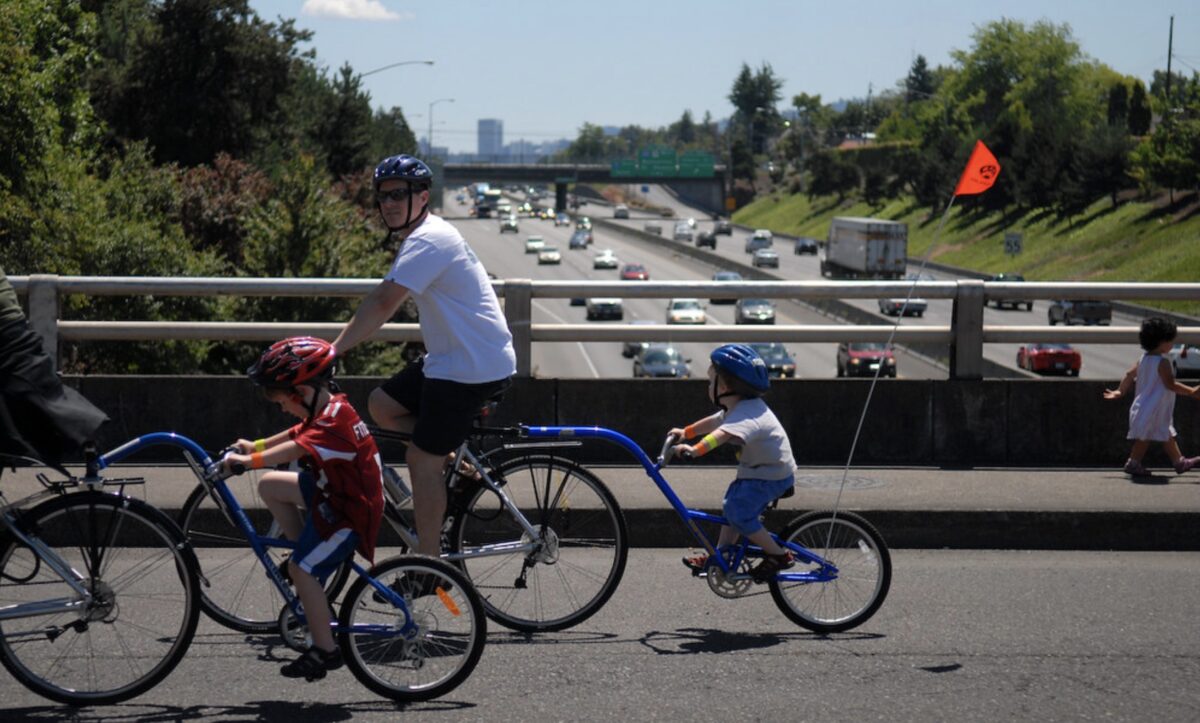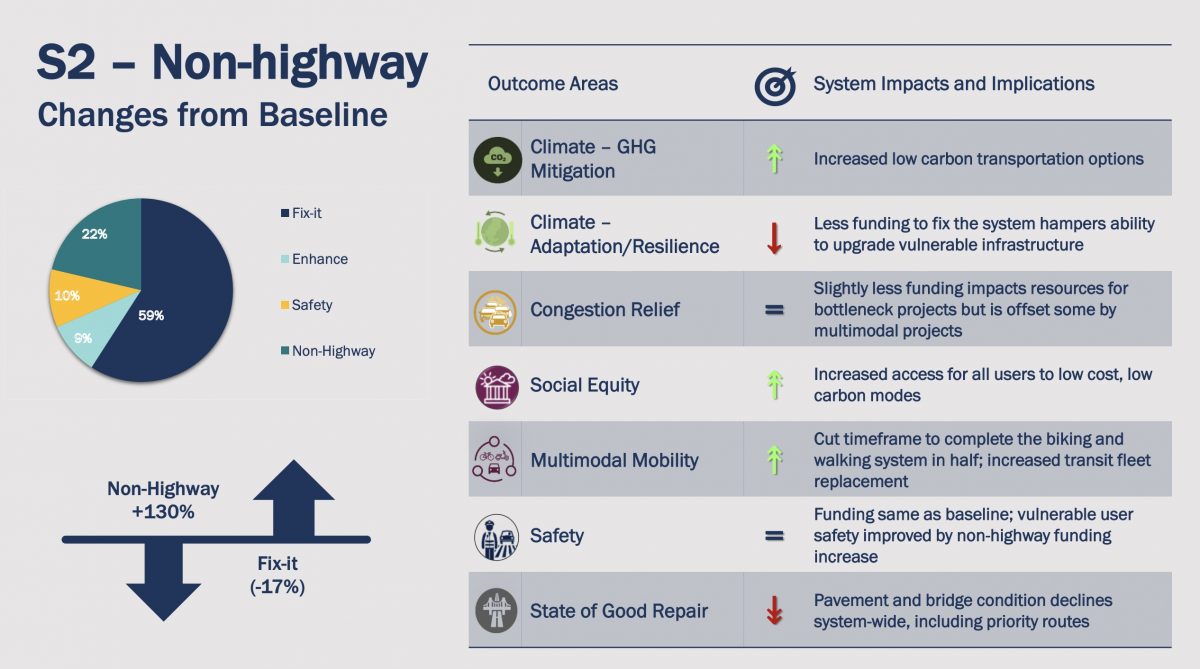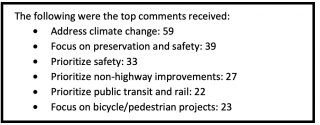
(Photo: Jonathan Maus/BikePortland)
“A large number of people talked about focusing on reducing greenhouse gas emissions.”
— Excerpt from ODOT STIP Public Input Summary
At their meeting on December 1st the unelected leaders of the Oregon Transportation Commission (OTC) will decide which direction to steer the Oregon Department of Transportation (ODOT) when it comes to spending $2.24 billion. It’s the first major decision point in development of the all-powerful 2024-2027 Statewide Transportation Improvement Program. Known as the “STIP”, it’s Oregon’s master list of infrastructure projects.
Left to their own devices, ODOT and statewide politicians are likely to invest our transportation dollars in a way that favors the status quo of driving. In fact, in a meeting of the Oregon Bicycle and Pedestrian Advisory Committee on November 18, an ODOT staffer revealed that if stay on the same funding path as the current STIP, it would take 150 years to build out Oregon’s network of bicycle and pedestrian projects.
But now isn’t the time to talk about specific projects. At this early stage in the STIP game it’s all about what funding categories will get the most attention. ODOT has broken down the funding pots into four main categories: Enhance (“Highway projects that expand or enhance the transportation system”), Fix-it (“Projects that maintain or fix the state highway system”), Non-Highway (“Bicycle, pedestrian, public transportation and transportation options projects & programs”), and Safety (“Projects focused on reducing fatal and serious injury crashes on Oregon’s roads”).
(Aside: These arbitrary categories and official definitions have lots of blurred lines and biases baked into them. An “enhancement” to one person might be a detriment to someone else. And “highway projects” can include significant amounts of bicycling and walking infrastructure. And let’s remember that “highways” aren’t always interstate freeways, many of them are roads that run through neighborhoods and main streets.)
Advertisement

ODOT has taken these funding categories and created five “scenarios” to help illustrate impacts to various agency goals and other tradeoffs that come with funding one category more or less than another. The scenarios are: Adjusted Baseline (keep things basically the same), Enhance, Non-Highway, Non-Highway/Safety, and Fix-it (see above). At their December meeting OTC members will choose which scenario to go forward with, thus setting into motion which type of projects are more likely to see some of that $2.24 billion.
In the past few months, government agencies, advocacy groups and activists of all stripes have sent in comments and letters to the OTC hoping to influence their decision.
Looming especially large this year is a focus on how investments will impact climate change. Back in March Oregon Governor Brown issued a executive order directing state agencies to reduce greenhouse emissions. She had specific marching orders for ODOT to, “develop and apply a process for evaluating the GHG implications of transportation projects in the STIP.” This has led to ODOT applying a “climate lens” to the STIP process for the first time ever. And as we shared last month, ODOT’s new climate office is already on the case.


To evaluate the different funding scenarios, ODOT created a matrix of rankings based on seven different outcomes — two of which related directly to climate change.
Several government agencies and advocates are pushing the OTC to adopt the “Non-Highway” scenario because it has the greatest positive impact on GHG reduction and climate resiliency.
A letter to the OTC from a coalition of transportation reform and social justice groups including Bike Loud PDX and the Oregon Environmental Council said, “The ‘Non-Highway’ scenario provides the most investment in the parts of our transportation system that provide the most positive effects on equity, air quality and climate pollution. The more people who are able to bike, walk and take transit, the more efficiently we can use our right-of-way while also reducing air toxics and greenhouse gas pollution and providing more freedom and access for people who do not or cannot drive. Also, non-highway projects provide more jobs per dollar spent than road-building projects.”
According to ODOT analysis, in the Non-Highway scenario, “the substantial increase in funding to [the non-highway category] cuts the timeframe to complete the bike-ped system in half.”
Advertisement
Mavis Hartz is a member of the La Grande School Board and chair of ODOT’s Safe Routes to School Advisory Committee. In her letter she implored the OTC to make a dent in the estimated $1 billion in projects within a one-mile radius of Oregon schools. “Being able to walk, take transit and bike to parks, stores, and places of employment is key to achieving Oregon’s climate goals,” she wrote.

The City of Milwaukie, led by its climate change-centric Mayor Mark Gamba, wrote that, “While none of the funding scenarios fully meet the needs of both adapting the system for climate resiliency and providing greater access to low carbon travel options, the city believes the non-highway option provides the greatest flexibility and tools to do so.” The Lane Area Commission on Transportation, an advisory group set up by ODOT to represent Eugene/Springfield and other cities in Lane County, also supports the Non-Highway funding scenario.
ODOT’s own public outreach showed broad support for investing in a way that tackles climate change. In a public input summary report made available to OTC members this week, ODOT wrote that out of all respondents to their online open house, “A large number of people talked about focusing on reducing greenhouse gas emissions as well as fixing the infrastructure we already have.” Of all the comments received, “address climate change” was the top-ranking subject.
Of course not everyone is on board with the Non-Highway scenario. Clackamas County supports thinks the “Enhance” scenario “strikes the right balance.”
The OTC, which is intended to be independent of ODOT but in reality is often their biggest cheerleader and a reliable rubber-stamp for whatever agency staff wants, is likely to talk about balance a lot at their meeting in December. If you want to help tip the scale, you can still comment directly to OTC members through December 1st.
This is the first step of the three-part STIP process. After funding allocations are decided it will be time to pick specific projects. The project list will then be up for public review and final approval by early 2023. Stay tuned to BikePortland and Learn more at ODOT’s website.
— Jonathan Maus: (503) 706-8804, @jonathan_maus on Twitter and jonathan@bikeportland.org
— Get our headlines delivered to your inbox.
— Support this independent community media outlet with a one-time contribution or monthly subscription.


